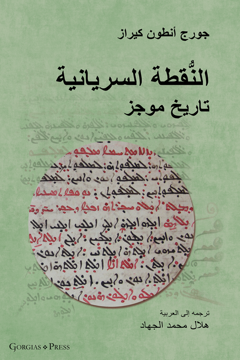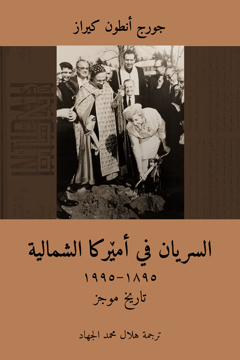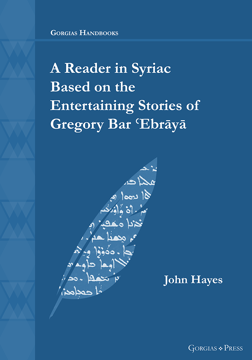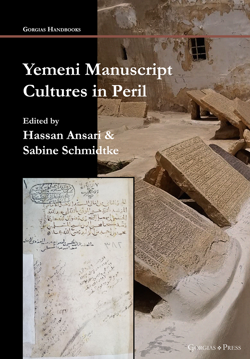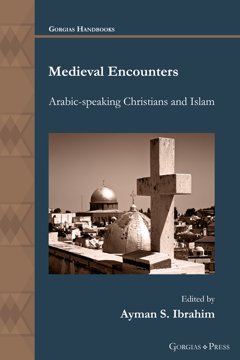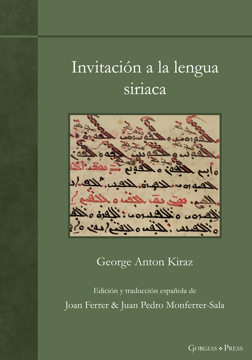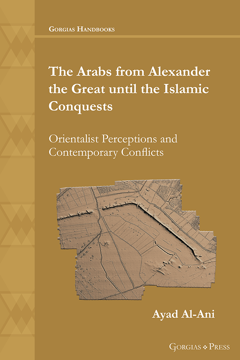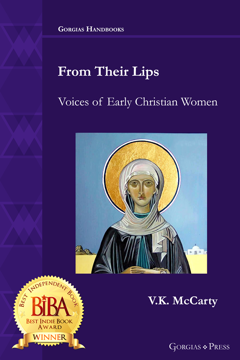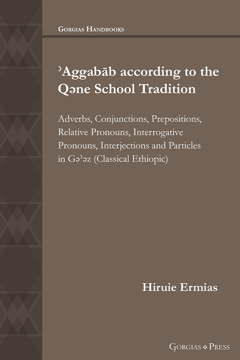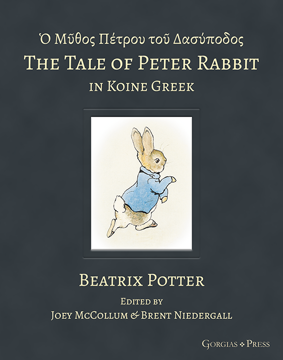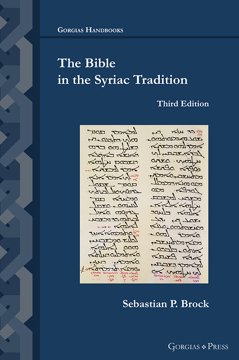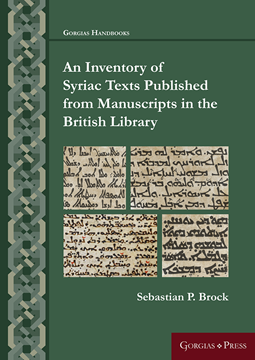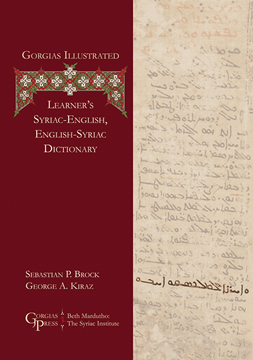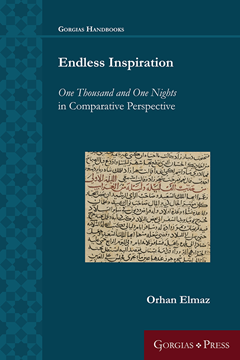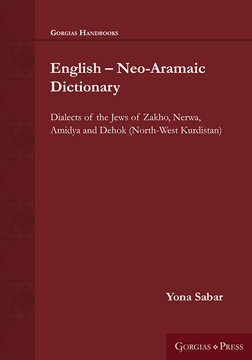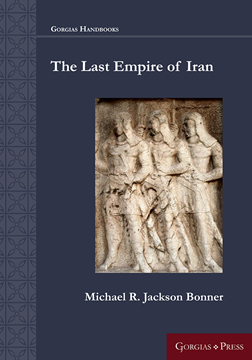Gorgias Handbooks
Gorgias Handbooks provides students and scholars with reference books, textbooks and introductions to different topics or fields of study. In this series, Gorgias welcomes books that are able to communicate information, ideas and concepts effectively and concisely, with useful reference bibliographies for further study.
An Introduction to the Five Scrolls
Song of Solomon, Ruth, Lamentations, Ecclesiastes, and Esther
Series: Gorgias Handbooks 67
ISBN: 978-1-4632-4808-6
An Introduction to the Five Scrolls: Song of Solomon, Ruth, Lamentations, Ecclesiastes, and Esther is a comprehensive introduction to the Megilloth, an important but often neglected minor collection of books in the Hebrew Bible. Using contemporary critical methods, each chapter explores title, authorship, provenance, place and time of composition, literary development, intended audience, literary structure, form, and style, literary and traditional sources, the contents and theological contribution, canonicity, and liturgical reception of the scrolls in both Jewish and Christian traditions. An Introduction to the Five Scrolls is the first comprehensive, critical introduction to the Five Scrolls to appear in English in recent scholarship.
$114.95 (USD) $91.96 (USD)
Water the Willow Tree (Arabic Edition)
Memoirs of a Bethlehem Boyhood
Series: Gorgias Handbooks 65
ISBN: 978-1-4632-4611-2
An Arabic translation of George A. Kiraz's engaging first memoir. The story of a young Palestinian boy growing up in Bethlehem, fascinated with understanding his Syriac roots even as he drew steadily nearer to the day when he would inevitably be transplanted to the United States.
$48.00 (USD) $28.80 (USD)
The Tale of Peter Rabbit in Classical Syriac
Translated by George Anton Kiraz
Series: Gorgias Handbooks 56
ISBN: 978-1-4632-4485-9
The Tale of Peter Rabbit in Classical Syriac is a retelling of Beatrix Potter’s classic tale for students of Classical Syriac as well as heritage readership. The vocabulary and expressions woven by George Kiraz draw not only on the language of the Peshitta Bible, but also on the language used in other texts, especially tales and colophons. Partially vocalized, the text aims to be readable to students of the language after completing a semester at the university level.
$28.00 (USD)
New Syriac Primer (Fourth Edition)
Series: Gorgias Handbooks 60
ISBN: 978-1-4632-4568-9
The Fourth Revised Edition of George A. Kiraz's Syriac Primer.
$48.00 (USD)
Lexical Aids to the Syriac New Testament (Third Expanded Edition)
Edited by George Anton Kiraz & Timothy A. Lee
Series: Gorgias Handbooks 61
ISBN: 978-1-4632-4603-7
Lexical Aids to the Syriac New Testament provides an essential tool to students of Syriac. A frequency-based glossary guides the student through the text of the Syriac New Testament’s most significant terms. In addition, verbal paradigms demystify the language’s structure, fostering a deeper understanding.
$58.00 (USD) $34.80 (USD)
The Syriac Peshiṭta New Testament (Reader's Edition)
Edited by Timothy A. Lee
Series: Gorgias Handbooks 62
ISBN: 978-1-4632-4605-1
This is the first Syriac reader for the New Testament. It guides the reader through the Syriac New Testament Peshitta, glossing the uncommon words and parsing difficult word forms.
$52.00 (USD)
The Syriac Peshiṭta Gospels (Reader's Edition)
Edited by Timothy A. Lee & Timothy A. Lee
Series: Gorgias Handbooks 63
ISBN: 978-1-4632-4607-5
This a Syriac reader for the Gospels. It guides the reader through the Syriac Peshitta Gospels, glossing the uncommon words and parsing difficult word forms.
$48.00 (USD)
Literary Snippets (Reader)
A Colophon Reader
Edited by George Anton Kiraz & Sabine Schmidtke
Series: Gorgias Handbooks 66
ISBN: 978-1-4632-4402-6
This companion volume to Literary Snippets: Colophons Across Space and Time (Gorgias Press, 2023) gives examples of colophons (and their translations) from the Ancient Near East up to the pre-modern world, in Akkadian, Hebrew, Arabic, Syriac, and Persian.
$114.95 (USD) $68.97 (USD)
Literary Snippets
Colophons Across Space and Time
Edited by George Anton Kiraz & Sabine Schmidtke
Series: Gorgias Handbooks 64
ISBN: 978-1-4632-4400-2
The colophon, the ultimate or “crowing touch” paragraphs of a manuscript or a book, provides readers with a the historical context in which the scribe produced the manuscript (or the publisher, a book). At its most fundamental level, the colophon gives us the “metadata” of the manuscript: who was the scribe? When and where was the manuscript produced? For whom was it produced and who paid for it? But colophons are far more rich. They are literary works in their own right, having a style and rhetoric independent of the main literary text of the manuscript. Some are assertive, providing contextual data about the scribe/publisher and manuscript/book; others are expressive, demonstrating the scribe’s feelings and wishes. Some are directive, asking the reader for an action; others declarative, providing all sorts of statements about the scribe/publisher or even the reader. The latter sometimes provide historical facts otherwise lost to histories: wars, earthquakes, religious events, legal agreements, etc. This edited volume brings together scholars from various disciplines to study colophons in various languages and traditions across space and time.
$120.00 (USD) $72.00 (USD)
The Syriac Dot / النُّقطة السريانية (Arabic Edition)
تاريخ موجز
By George Anton Kiraz; Translated by Hilal Mohammad Al-Jihad
Series: Gorgias Handbooks 58
ISBN: 978-1-4632-4543-6
The dot is used for everything in Syriac from tense to gender, number, and pronunciation, and unsurprisingly represents one of the biggest obstacles to learning the language. In this Arabic-language edition of his book, Dr. Kiraz peels back the evolution of the dot layer by layer to explain each of its uses in detail and to show how it adopted the wide range of uses it has today.
$52.00 (USD) $31.20 (USD)
The Syriac Orthodox in North America (1895–1995) / السريان في أمێركا الشمالية (Arabic Edition)
تاريخ موجز
By George Anton Kiraz; Translated by Hilal Mohammad Al-Jihad
Series: Gorgias Handbooks 59
ISBN: 978-1-4632-4545-0
An Arabic translation of George Anton Kiraz's 'The Syriac Orthodox in North America (1895–1995)' – a short history of the Syriac Orthodox community in North America between 1895, the year of the First Sayfo that triggered the first wave of immigration to North America, and 1995, marking the passing away of Metropolitan Mor Athanasius Yeshue Samuel, the first and only Archbishop of the Syriac Orthodox Archdiocese of the United States and Canada.
$42.00 (USD)
A Reader in Syriac Based on the Entertaining Stories of Gregory Bar ʿEbrāyā
Series: Gorgias Handbooks 57
ISBN: 978-1-4632-4489-7
Thirty short reading selections from the Book of Entertaining Stories of Gregory Bar ʿEbrāyā, with an analysis of the grammar and vocabulary of the texts.
$47.50 (USD) $28.50 (USD)
Yemeni Manuscript Cultures in Peril
Edited by Hassan Ansari & Sabine Schmidtke; Contribution by Stefanie Brinkmann, Gabriele vom Bruck, Bernard Haykel, Brinkley Messick, Christoph Rauch, Anne Regourd, Valentina Sagaria Rossi, Karin Scheper, Jan Thiele, Daniel Martin Varisco, Arnoud Vrolijk & Zaid bin Ali al-Wazir
Series: Gorgias Handbooks 49
ISBN: 978-1-4632-4202-2
The most significant and by far largest collections of Zaydi manuscripts are housed by the many public and private libraries of Yemen, an endangered cultural heritage tradition, currently at risk due to the conflict and warfare in Yemen. The contributions brought together in this volume address a wide spectrum of aspects concerning Yemeni manuscript cultures, with some focusing on their history and present state within Yemen and others discussing the collections of manuscripts of Yemeni provenance in Europe and elsewhere.
$48.00 (USD)
Medieval Encounters
Arabic-speaking Christians and Islam
Edited by Ayman S. Ibrahim; Contribution by Mark Beaumont, David Bertaina, Clint Hackenburg, Sandra Toenies Keating, Michael F. Kuhn, John C. Lamoreaux, Mourad Takawi, Jack Tannous, Alexander Treiger & Mina Yousef
Series: Gorgias Handbooks 55
ISBN: 978-1-4632-4447-7
A sourcebook of major Arabic Christian theologians and texts from the 9th-11th centuries. Christian authors who spoke and wrote Arabic had no choice but to engage with Islam and the complex realities of life—initially as a majority, later as a minority—under Muslim rule. They had to express their theology in new ways, polemicize against the claims of a new religion, as well as defend their doctrines against Islam’s challenges.
$55.00 (USD)
Invitación a la lengua siriaca
Series: Gorgias Handbooks 36
ISBN: 978-1-4632-0636-9
A Spanish translation of George Kiraz's popular New Syriac Primer. This fruitful integration of scholarly introduction and practical application provides a primer that is more than a simple grammar or syntactic introduction to the language. Written in a style designed for beginners, Kiraz avoids technical language and strives for a reader-friendly inductive approach.
$48.00 (USD)
The Arabs from Alexander the Great until the Islamic Conquests
Orientalist Perceptions and Contemporary Conflicts
By Ayad Al-Ani
Series: Gorgias Handbooks 54
ISBN: 978-1-4632-4285-5
This is not a conventional history book. It is rather a study of the sociology of historical writing about a period that, although quite distant in time (330 B.C. to A.D. 670), still influences political discourse about the Arab world, and especially the relationship between the West and the Middle East. This book focuses on the riddle of the disappearance of the Arabs from history before Islam, their sudden appearance behind the banners of the Prophet, and the powerful and traumatic effect this emergence into world history has had on the relationship between the Arabs and the West.
$62.50 (USD)
From Their Lips
Voices of Early Christian Women
By VK McCarty
Series: Gorgias Handbooks 53
ISBN: 978-1-4632-4255-8
The Church venerates among its saints several Early Christian women whose teaching and wisdom contribute to the depth of our theological heritage. Their inspired voices can be heard at work witnessing: in the New Testament, in the early centuries of the Church Fathers and throughout the Byzantine era. Readers will find this volume bringing female leaders from the Early Church to life from the traditional ancient sources and sharing their experience of the presence of God. Their remembered advice to followers still illuminates issues of faith and justice which bind us together as Christians today.
$48.00 (USD) $28.80 (USD)
ʾAggabāb according to the Qəne School Tradition
Adverbs, Conjunctions, Prepositions, Relative Pronouns, Interrogative Pronouns, Interjections and Particles in Gəʾəz (Classical Ethiopic)
Series: Gorgias Handbooks 48
ISBN: 978-1-4632-4206-0
This book deals with various linguistic elements of Gǝʿǝz (Classical Ethiopic). More than two hundred and thirty-four linguistic elements are discussed, categorized into seven lexical categories: Adverbs, conjunctions, prepositions, relative pronouns, interrogative pronouns, interjections, and particles. Dealing with their etymologies, meanings and grammatical functions is the particular focus of the work. To make the study clearer and easier to understand, appropriate examples and relevant textual sources are given for each theory or analysis.
$77.00 (USD) $46.20 (USD)
The Tale of Peter Rabbit in Koine Greek
Edited by Joey McCollum & Brent Niedergall
Series: Gorgias Handbooks 51
ISBN: 978-1-4632-4223-7
A translation of Beatrix Potter's Tale of Peter Rabbit in Koine Greek, using only vocabulary found in the Greek New Testament and Septuagint (including the Apocrypha), and illustrated with Potter's original drawings.
$23.00 (USD)
The Bible in the Syriac Tradition (Third Edition)
Series: Gorgias Handbooks 52
ISBN: 978-1-4632-4233-6
This is a basic introduction to the various Syriac translations of the Bible and the ways in which they were used in the Syriac tradition. After an initial discussion of the general problems of biblical translation, the different surviving Syriac translations are outlined, as well as biblical manuscripts, lectionaires, printed editions, and translations. A reception history of the Syriac Bible covers the ways in which it has been interpreted, the commentary tradition, its use in preaching, in liturgy, and in spirituality. An appendix offers some comparative samples (in translation) to illustrate some of the differences between the different Syriac translations.
$53.00 (USD) $31.80 (USD)
An Inventory of Syriac Texts Published from Manuscripts in the British Library
Series: Gorgias Handbooks 50
ISBN: 978-1-4632-4214-5
The British Library possesses one of the most important collections of Syriac manuscripts in the world, with large numbers dating back to the second half of the first millennium CE. The publication of important Syriac texts from these manuscripts has been going on for some 180 years and still continues. The aim of the present volume is to provide a guide to these scattered publications: following the sequence of the shelf-marks (call numbers), for each manuscript indication is given of what texts have been published from it. For convenience, a concordance between Wright’s Catalogue numbers and shelf-marks is provided, along with a list of palimpsests and of joins with manuscripts in other libraries, in particular with those still in the Library of Dayr al-Surian in Egypt, the monastery which was the source of over 500 manuscripts and fragments purchased by the British Museum in the mid nineteenth century.
$149.00 (USD) $89.40 (USD)
Gorgias Illustrated Learner's Syriac-English, English-Syriac Dictionary
Series: Gorgias Handbooks 46
ISBN: 978-1-4632-4180-3
The Gorgias Illustrated Learner's Syriac English, English-Syriac Dictionary is both a convenient academic resource and a door into the world of Modern Literary Syriac. With 13,000 entries drawn from the major existing works, alongside dozens of explanatory boxes on biblical, historical, theological, liturgical, cultural, as well as grammatical topics, and over 80 colored illustrations, it is a practical tool for those that wish to access all but the most specialized Classical Syriac texts.
$48.00 (USD)
Endless Inspiration
One Thousand and One Nights in Comparative Perspective
Edited by Orhan Elmaz
Series: Gorgias Handbooks 47
ISBN: 978-1-4632-0720-5
This volume deals with One Thousand and One Nights in yet another and novel way as it brings old and new together by exploring parallels and possible origins of its tales, as well as the wealth of modern and contemporary material that it has originated and continues to inspire. The papers included in this volume address the theory and practice of the adaptation and appropriation of One Thousand and One Nights into any type of literary text and media, while approaching a definition of our contemporary knowledge and understanding of the Nights. Through this, it will be possible to underline the dynamic nature and autonomous life that the tale collection acquired and how it originated works like Jorge Luis Borges’s essays, Naguib Mahfouz’s works, Miguel Gomes’s trilogy, a Turkish soap opera that became popular around the world and made it to Netflix, or Nikolai Rimsky-Korsakov’s well-known symphonic suite.
$114.95 (USD) $68.97 (USD)
English - Neo-Aramaic Dictionary
Dialects of the Jews of Zakho, Nerwa, Amidya and Dehok (North-West Kurdistan)
By Yona Sabar
Series: Gorgias Handbooks 45
ISBN: 978-1-4632-4144-5
Based on Sabar's 2002 Jewish Neo-Aramaic dictionary, this dictionary serves a functional purpose for readers and scholars who would like to know the Neo-Aramaic vocabulary. It does not include grammatical or semantic details but does include the origin of the words, be it native Old Aramaic, and, in the case of loanwords, the original lending language, Arabic, Kurdish, Persian, Turkish, etc.
$55.50 (USD)
The Last Empire of Iran
Series: Gorgias Handbooks 44
ISBN: 978-1-4632-0616-1
As part of the Gorgias Handbook Series, this book provides a political and military history of the Sasanian Empire in Late Antiquity (220s to 651 CE). The book takes the form of a narrative, which situates Sasanian Iran as a continental power between Rome and the world of the steppe nomad.
$90.00 (USD) $54.00 (USD)










